Are the plants in your self-watering pots declining, and you can’t understand why?
While self-watering pots can work wonders, many people fail to realize they aren’t for every type of plant. Cacti, succulents, some herbs, orchids, and more cannot tolerate “wet feet” and will suffer or even die in a self-watering planter.
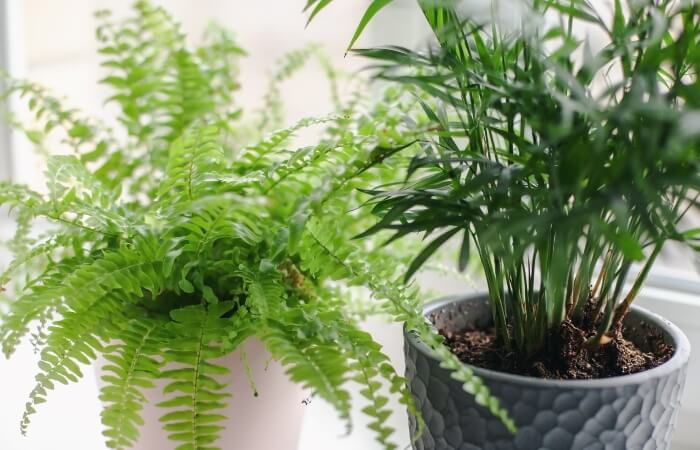
I put together this quick-reference guide to highlight seven plants that thrive in self-watering pots along with bonus growing tips. With the right plant, you can optimize the look and health of your flowers, herbs, veggies, and more!
All the following plants do best with consistently moist soil, which self-watering planters provide. Without needing to always water and fuss over your plants, you can have more time to enjoy them!
Ferns (Tracheophyta Polypodiopsida)
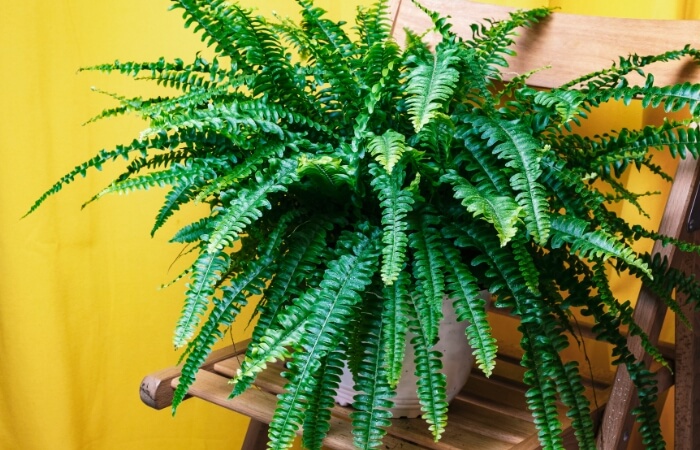
Whether indoors or out, most species of ferns are a top choice for self-watering planters, as the roots drink up plenty of moisture from the soil.
Ferns also collect moisture from the surrounding air, which makes them perfect for adding a touch of nature in bathrooms.
Foliage:
Ferns are non-flowering but show off a long stem with rows of individual green leaves which grow smaller toward the tip.
These varieties of ferns are most suitable for self-watering planters:
- Ostrich fern
- Boston fern
- American Maidenhair fern
- Regal Red Japanese Painted fern
Growing Tips:
Ferns grow best in bright to moderate indirect light, so outdoors, place them under trees or in areas that provide shade most of the day.
Indoors choose east or west-facing windowsills or tables, or if in a south-facing room, position the pot well away from windows.
Keeping your pot’s reservoir full is crucial, as ferns will discolor quickly with a lack of moisture.
Baby’s Tears (Soleirolia Soleirolii)

Baby’s Tears love moisture so much. It’s a favorite plant for use in terrariums. The foliage will also drape over pot edges and create vines that make it ideal for hanging planters as well.
Foliage:
The plant forms a dense grouping of vibrant green foliage. The teardrop-shaped leaves form a delicate central stem that will grow into long tendrils if left alone.
Growing Tips:
Place potted Baby’s Tears in a medium to low-light setting, avoiding direct sunlight exposure.
Use a well-draining potting mix, as the plant will die if roots remain soggy, but also never let the soil dry out.
Umbrella Palm (Cyperus Alternifolius)
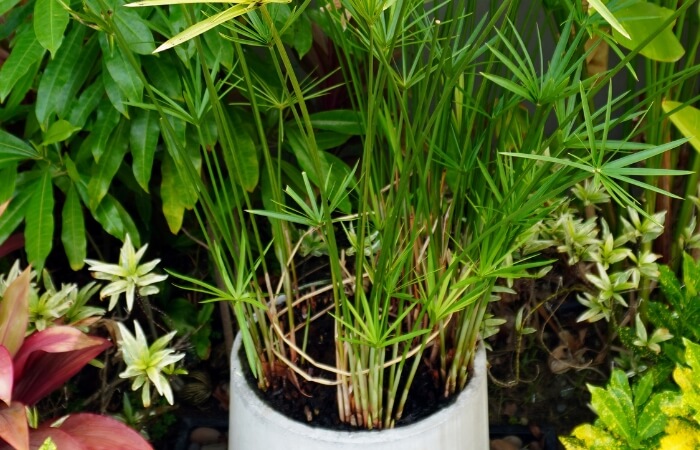
Umbrella palms are tropical swamp natives, so it’s logical these plants are an excellent choice for the abundant moisture self-watering planters deliver.
For indoor use, many people opt for the dwarf variety, as the plant can grow up to six or more feet tall.
Another benefit of this palm is that root rot is not a concern, as this plant can tolerate full-time submersion of its roots without harm.
The plant is also ideal for rooms with dry air, as it releases moisture from its foliage into its surroundings, making it nature’s humidifier.
Foliage:
Umbrella palms form rich green foliage. Thick main stems shoot up several feet and burst at the top with an umbrella of long, thin bracts that angle upwards.
The plant does flower, but the green blooms are not exceptionally showy.
Growing Tips:
Indoors or out, Umbrella palms can tolerate sunlight, but intense direct sunlight can burn the leaves, so position them to allow for partial shade most of the day.
Fertilize once a year, and prune off root growth that tends to overflow from the top of the pot as the plant keeps searching for even more water.
Nepenthes Alata Pitcher Plant (Saccacenia)
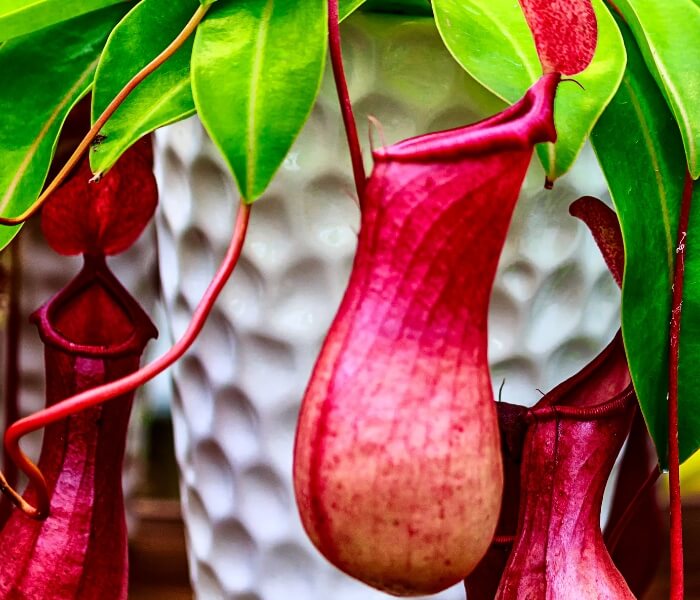
Pitcher plants are native to bogs, so continual water is a blessing for these unique carnivorous specimens.
Aside from feasting on the wayward insects it attracts with its scented and colorful pitchers, it works well in hanging self-watering planters to allow the pitchers to hang freely.
Foliage:
Darker green foliage comes in leaves that are long and oblong. The stems grow upwards with the leaves protruding around the perimeter in a stacked formation.
The colorful pitcher “flowers” form from the tips of the leaves, causing a drooping appearance to the foliage.
Growing Tips:
Pot with an equal mix of dried sphagnum moss and perlite. Potting soil has nutrients that are harmful to carnivorous plants.
Only give pitcher plants distilled water or rainwater, as minerals can build up in the soil and cause death.
It does excellent in sunny windows, as long as direct sunlight is limited to three or four hours a day.
The plant can falter under extreme cold but can grow well outdoors in southern regions with sub-tropical weather.
Herbs

Herbs such as basil, coriander, parsley, and rocket all do well in small self-watering pots. A shallow depth to the pot makes it simple to clip off herbs as you need them.
Foliage:
The foliage of most herbs is small and comes in a lovely shade range of greens, making them a beautiful addition to kitchen decor.
Growing Tips:
Make sure your potting soil has perlite to increase drainage and increase aeration so roots don’t rot.
Set the pots in sunny windowsills indoors. Outdoors choose a location where it can receive either direct morning or afternoon sun.
A planter with a water gauge or drainage hole for excess water is helpful when growing herbs, as you never want to overwater.
Japanese Iris (Iris Ensata)

Japanese Iris thrives in moist soil and grows well in nearly all growing zones, which makes this a no-brainer for self-watering planters that are more round and wide.
The colorful blooms add interest and energy to an otherwise boring space.
Foliage:
The long, deep-green leaves are full as they emerge from the base of the stem and then taper to a point.
Large, showy flowers bloom in late spring and come in a variety of shades, with purple being the most common color.
Growing Tips:
Plant in nutrient-rich potting soil and allow for six to eight hours of full sun daily (necessary for the iris to bloom), whether indoors or out.
Cherry Tomatoes
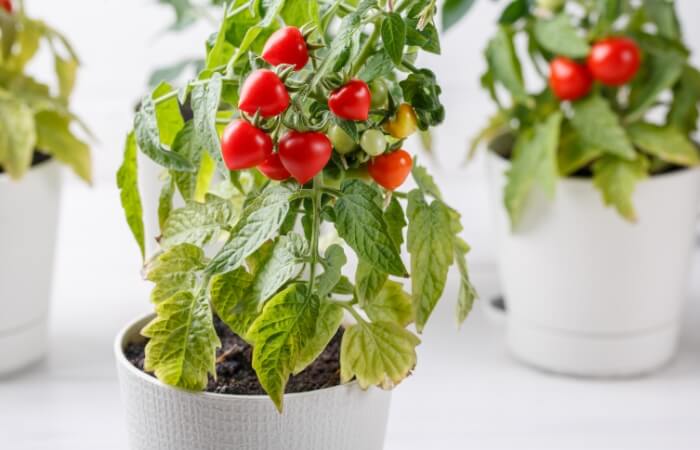
Cherry tomatoes love consistent moisture and, with the addition of a growing trellis, are a great addition for self-watering pots.
If tomatoes aren’t your thing, then consider these other vegetables that thrive in these planters:
- Lettuce
- Peppers
- Eggplants
- Pole beans
- Chard
- Summer squash
Growing Tips:
Vegetables are best grown in pots outdoors in a sunny location, but some can grow indoors in a well-ventilated, bright area.
Don’t panic if the soil goes dry for a day or two, as most veggie plants (outside of lettuce) can survive any short episodes.










